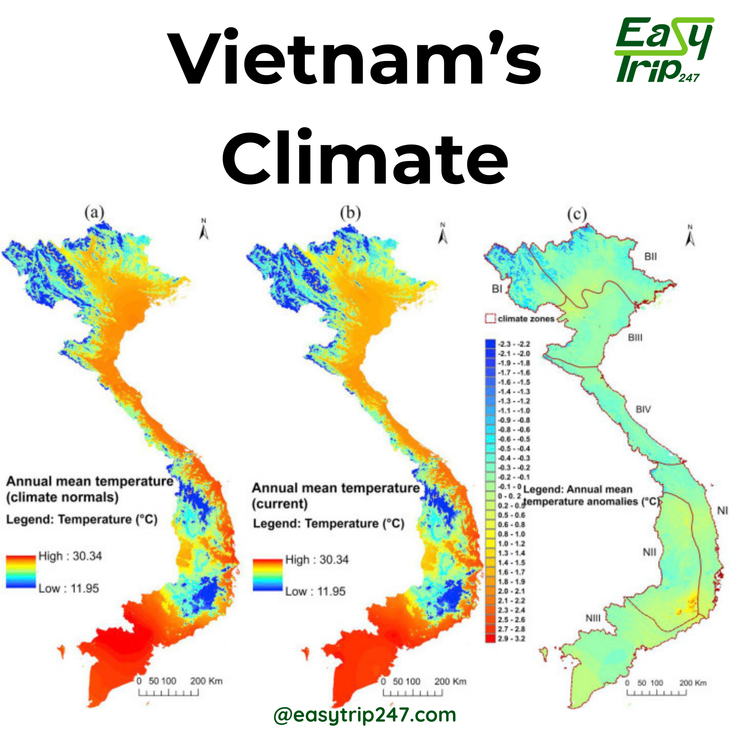Vietnam’s Climate: What to Expect Each Month
On
23/06/2025Reading time:
1 min
Summary:
When planning a trip to Vietnam, the country's climate is one of the most important factors to consider. With its long, narrow shape and diverse topography, Vietnam offers a variety of weather patterns that change significantly from one region to another.

Vietnam doesn’t have one uniform climate. Instead, it experiences three different climate zones: the north, the central region, and the south. Each zone brings its own rhythms of dry seasons, rainy spells, and transitional months. So let’s break down Vietnam’s climate month by month—helping you discover the best time to visit Vietnam for your ideal journey.
January – Cool North, Sunny South
In January, northern Vietnam experiences its coolest temperatures. Hanoi sees average lows of 14°C (57°F), and in higher elevations like Sapa, it can drop even lower. Expect misty mornings and a romantic, moody ambiance in the mountains. Meanwhile, central Vietnam (Hue, Da Nang) is still recovering from the rainy season, though the weather begins to stabilize.
The south, however, is enjoying one of its finest months. Ho Chi Minh City and Phu Quoc bask in the dry season, with plenty of sunshine and blue skies. If you prefer sun, sand, and a break from winter, January may be the best time to visit Vietnam.
February – Festivities and Sunshine
February is a vibrant month thanks to Tet, the Lunar New Year celebration. It’s a fantastic time to experience Vietnam’s cultural heart, even though some businesses briefly close. The north remains cool but dry, with pleasant conditions for city walks and heritage exploration.
The central coast improves in terms of weather, and the south continues to shine with consistent warmth and little rain. February is the best time to visit Vietnam if you want to combine cultural immersion with beautiful weather—particularly in the south.
March – Comfortable and Clear
March offers some of the most stable weather across all three regions. The north warms up slightly, losing its winter chill, and the sun begins to peek through more consistently. Central Vietnam becomes increasingly dry and warm, and the south continues to enjoy peak dry-season conditions.
Whether you're trekking in the highlands, cruising through Halong Bay, or relaxing on a central beach, March stands out as one of the best times to visit Vietnam for all-around enjoyable weather.
April – Green Landscapes and Sunshine
April is a transitional month but still a favorable one. The north is comfortably warm, the central region sees more sunshine and less rain, and southern Vietnam starts to feel the first hints of increased humidity.
April is especially great for nature lovers. National parks like Cuc Phuong and Cat Ba come alive with lush greenery, and flower gardens bloom in cities like Dalat. With clear skies and mild temperatures still in place, April can easily be the best time to visit Vietnam for scenic adventures and off-the-beaten-path exploration.
May – Start of the Summer Shift
May signals the start of summer and brings warmer temperatures throughout the country. Rain showers begin to appear, particularly in the north and south, but they are often brief and refreshing.
The central coast, including Hoi An and Nha Trang, remains relatively dry, offering beach-goers plenty of sunshine. For those seeking fewer tourists and beautiful coastal weather, May might just be the best time to visit Vietnam.
June – Beach Season in Central Vietnam
June gets hotter, and rains become more frequent in the north and south. Despite this, central Vietnam enjoys excellent conditions, with Da Nang, Quy Nhon, and Nha Trang emerging as top beach destinations.
Though humidity increases, the landscapes turn beautifully green, and the sea remains warm and inviting. If your ideal getaway includes sunbathing and fresh seafood, June could still be the best time to visit Vietnam, particularly along the central coast.
July – Lush Landscapes, Local Vibes
By July, Vietnam is deep into its summer season. Rain is more common, especially in the north and south, but don’t let that deter you. The rains are typically short-lived and often come in the late afternoon. You’ll still enjoy warm mornings and active days.
This is a great time to visit lesser-known destinations, explore local markets, and enjoy the emerald-green countryside. With fewer international tourists around, July might be the best time to visit Vietnam if you want to connect with the local rhythm of life.
August – A Month of Tropical Energy
August continues the summer pattern: hot, humid, and rainy in many areas. However, central Vietnam still sees decent weather, making it a popular spot for domestic travelers. The cultural richness of Hue and the laid-back beaches of Hoi An remain attractive.
If you're a traveler who doesn’t mind the occasional rain and wants to avoid large crowds, August could be the best time to visit Vietnam—especially if you stick to the central region or enjoy indoor cultural attractions.
September – Rice Harvest and Change in the Air
In September, the weather begins to shift again. The north sees a decline in rainfall, with golden rice terraces ready for harvest in places like Mu Cang Chai and Sapa. This is one of the most photogenic times of year for northern Vietnam.
Although the central coast begins to receive more rain, early September can still be enjoyable. The south slowly starts drying out toward the month’s end. For photographers and culture enthusiasts, September may be the best time to visit Vietnam to witness authentic rural life and vibrant harvest scenes.
October – Autumn Perfection
October is beloved by many as one of the most pleasant months in Vietnam. Northern regions are cool and dry, perfect for hiking and sightseeing. Central Vietnam can be rainy, but southern Vietnam starts to shine again.
It’s a fantastic month to explore Hanoi, cruise through Halong Bay, or relax on beaches in the southern provinces. For overall comfort, beautiful colors, and cultural activities, October often earns the title of best time to visit Vietnam.
November – Blue Skies and Cool Breezes
November brings blue skies, lower humidity, and a sense of freshness across the country. The north is crisp but still warm enough for comfort. Central Vietnam dries up after the rainy season, and the south reenters its most beautiful weather phase.
This is one of the most popular travel months and for good reason. Whether you’re after trekking, cultural festivals, or beach retreats, November is a strong contender for the best time to visit Vietnam.
December – Mild, Magical, and Festive
December offers ideal travel conditions, particularly in the south and central regions. Ho Chi Minh City is vibrant, festive, and sunny. Phu Quoc and Con Dao offer the perfect winter escape for beach lovers.
Northern Vietnam gets chilly, especially in mountainous areas, but the cool air adds charm to cities like Hanoi and Ninh Binh. With the holiday season in the air and pleasant weather throughout most of the country, December rounds out the year as the best time to visit Vietnam for a memorable experience.
Conclusion: Let the Climate Guide Your Journey
Vietnam’s climate is rich, complex, and varied—just like the country itself. Every month brings a new mood and a different backdrop to your travels. Whether you’re drawn to misty mountains, golden rice terraces, sunlit beaches, or bustling markets, understanding what to expect from Vietnam’s weather each month allows you to plan your adventure more meaningfully.
There’s no single answer to the question of the best time to visit Vietnam, but with this guide, you’re one step closer to discovering the perfect time for you. No matter when you go, Vietnam welcomes you with open arms, incredible flavors, breathtaking sights, and a culture that leaves a lasting imprint on the heart.
Design Your Tour Today And Get A Quote. Contact Us Here: +84.975.504.825
Source: Easytrip247 Team compiled.
